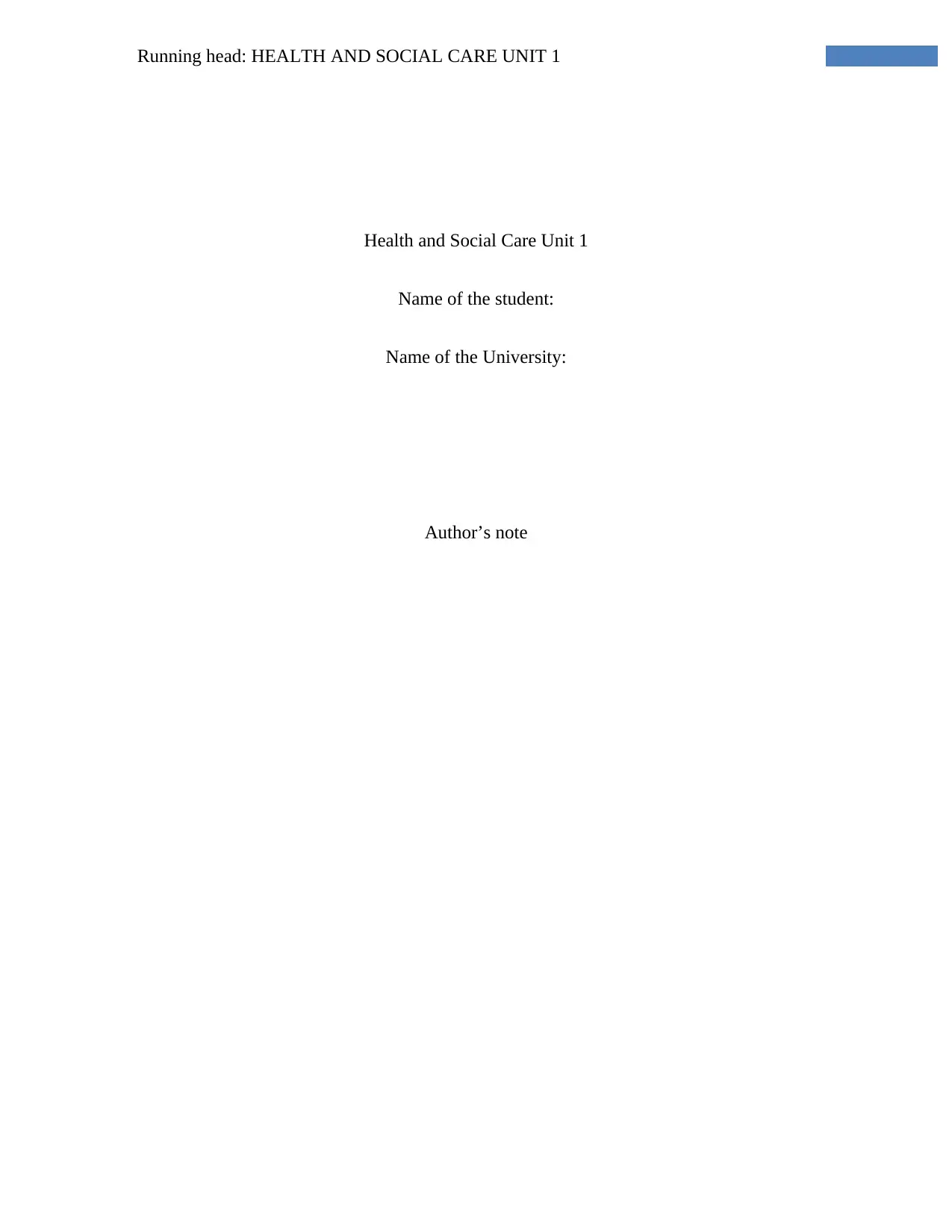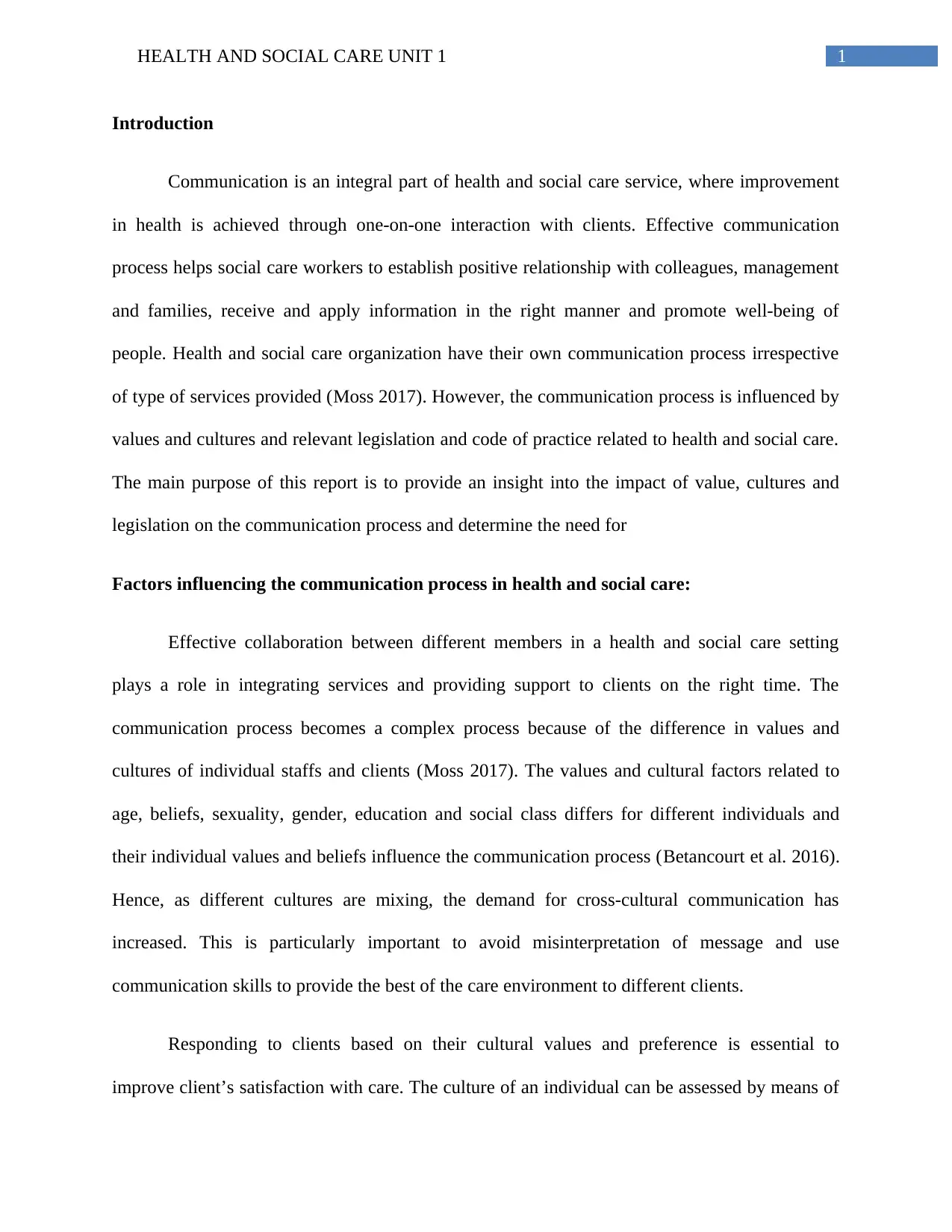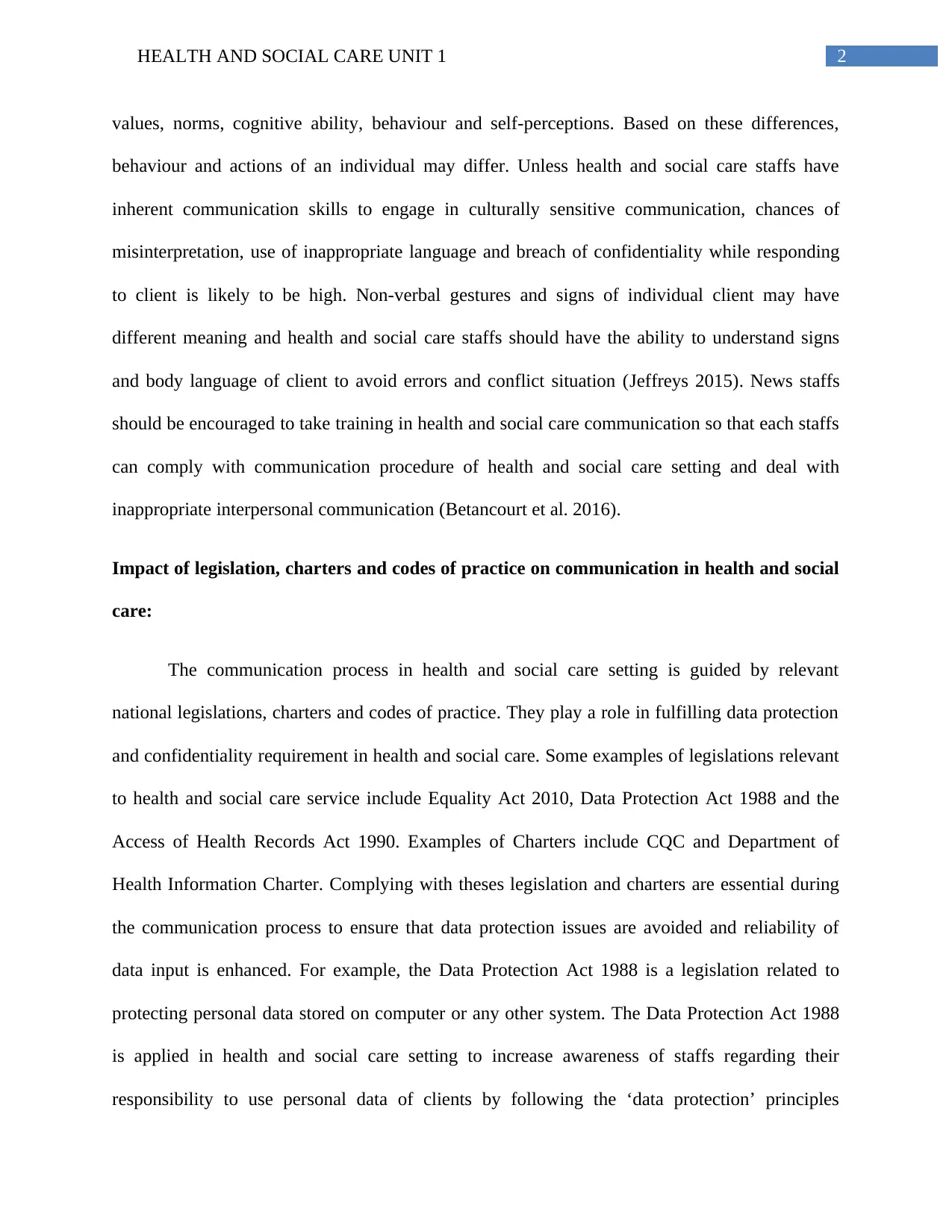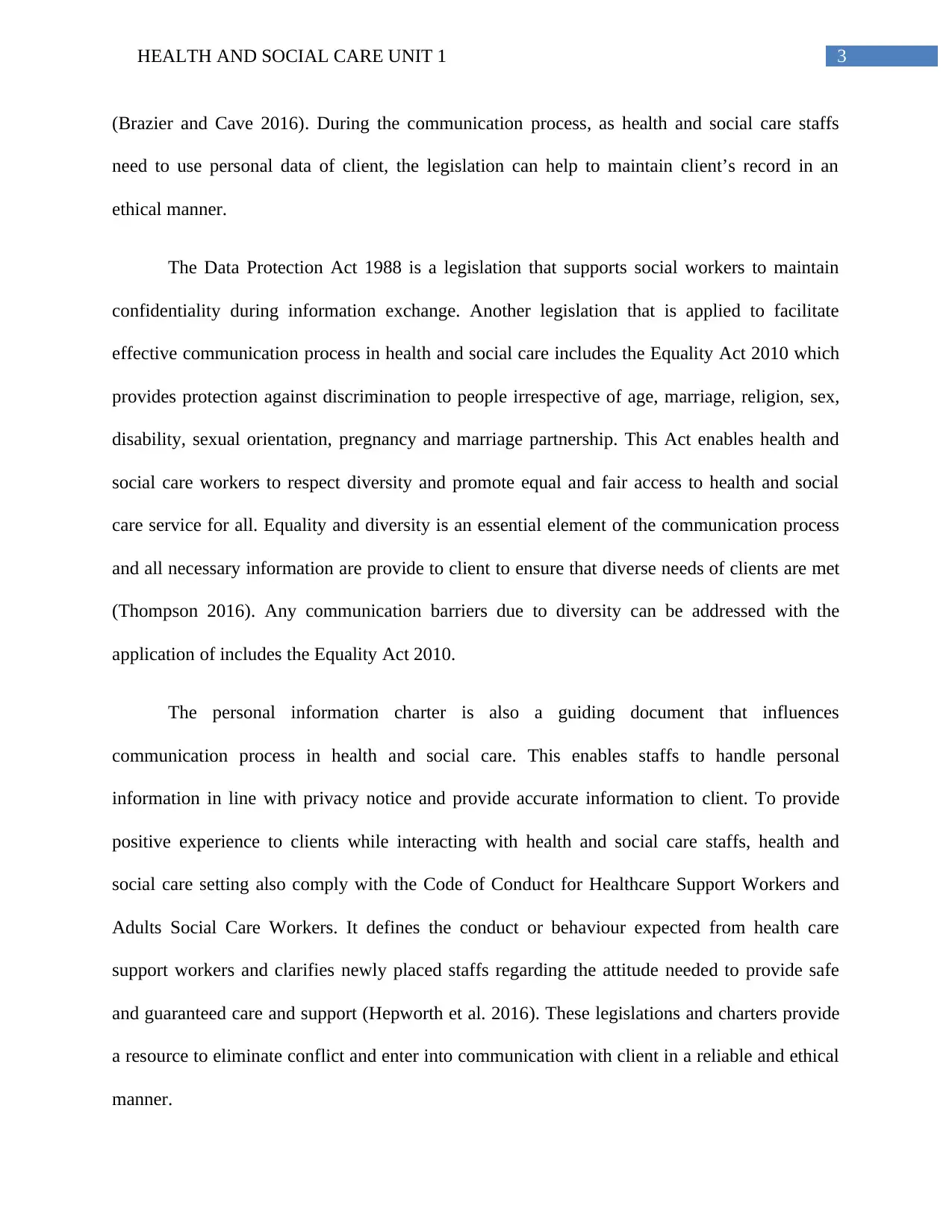Communication Processes: Health and Social Care Unit 1 Analysis
VerifiedAdded on 2021/06/17
|7
|1740
|51
Report
AI Summary
This report provides a detailed analysis of communication processes within health and social care settings. It explores the influence of cultural values, beliefs, and norms on communication, emphasizing the importance of cross-cultural communication to avoid misunderstandings and provide client-centered care. The report examines the impact of relevant legislation, charters, and codes of practice, such as the Data Protection Act 1988 and the Equality Act 2010, on ensuring data protection, confidentiality, and equal access to services. Furthermore, it assesses the effectiveness of organizational systems and policies in promoting good communication practices, highlighting the need for regular updates and evaluations to address limitations and improve service quality. The report concludes by emphasizing the importance of adapting organizational practices to meet the unique communication needs of individual clients and providing adequate support to healthcare workers.

Running head: HEALTH AND SOCIAL CARE UNIT 1
Health and Social Care Unit 1
Name of the student:
Name of the University:
Author’s note
Health and Social Care Unit 1
Name of the student:
Name of the University:
Author’s note
Paraphrase This Document
Need a fresh take? Get an instant paraphrase of this document with our AI Paraphraser

1HEALTH AND SOCIAL CARE UNIT 1
Introduction
Communication is an integral part of health and social care service, where improvement
in health is achieved through one-on-one interaction with clients. Effective communication
process helps social care workers to establish positive relationship with colleagues, management
and families, receive and apply information in the right manner and promote well-being of
people. Health and social care organization have their own communication process irrespective
of type of services provided (Moss 2017). However, the communication process is influenced by
values and cultures and relevant legislation and code of practice related to health and social care.
The main purpose of this report is to provide an insight into the impact of value, cultures and
legislation on the communication process and determine the need for
Factors influencing the communication process in health and social care:
Effective collaboration between different members in a health and social care setting
plays a role in integrating services and providing support to clients on the right time. The
communication process becomes a complex process because of the difference in values and
cultures of individual staffs and clients (Moss 2017). The values and cultural factors related to
age, beliefs, sexuality, gender, education and social class differs for different individuals and
their individual values and beliefs influence the communication process (Betancourt et al. 2016).
Hence, as different cultures are mixing, the demand for cross-cultural communication has
increased. This is particularly important to avoid misinterpretation of message and use
communication skills to provide the best of the care environment to different clients.
Responding to clients based on their cultural values and preference is essential to
improve client’s satisfaction with care. The culture of an individual can be assessed by means of
Introduction
Communication is an integral part of health and social care service, where improvement
in health is achieved through one-on-one interaction with clients. Effective communication
process helps social care workers to establish positive relationship with colleagues, management
and families, receive and apply information in the right manner and promote well-being of
people. Health and social care organization have their own communication process irrespective
of type of services provided (Moss 2017). However, the communication process is influenced by
values and cultures and relevant legislation and code of practice related to health and social care.
The main purpose of this report is to provide an insight into the impact of value, cultures and
legislation on the communication process and determine the need for
Factors influencing the communication process in health and social care:
Effective collaboration between different members in a health and social care setting
plays a role in integrating services and providing support to clients on the right time. The
communication process becomes a complex process because of the difference in values and
cultures of individual staffs and clients (Moss 2017). The values and cultural factors related to
age, beliefs, sexuality, gender, education and social class differs for different individuals and
their individual values and beliefs influence the communication process (Betancourt et al. 2016).
Hence, as different cultures are mixing, the demand for cross-cultural communication has
increased. This is particularly important to avoid misinterpretation of message and use
communication skills to provide the best of the care environment to different clients.
Responding to clients based on their cultural values and preference is essential to
improve client’s satisfaction with care. The culture of an individual can be assessed by means of

2HEALTH AND SOCIAL CARE UNIT 1
values, norms, cognitive ability, behaviour and self-perceptions. Based on these differences,
behaviour and actions of an individual may differ. Unless health and social care staffs have
inherent communication skills to engage in culturally sensitive communication, chances of
misinterpretation, use of inappropriate language and breach of confidentiality while responding
to client is likely to be high. Non-verbal gestures and signs of individual client may have
different meaning and health and social care staffs should have the ability to understand signs
and body language of client to avoid errors and conflict situation (Jeffreys 2015). News staffs
should be encouraged to take training in health and social care communication so that each staffs
can comply with communication procedure of health and social care setting and deal with
inappropriate interpersonal communication (Betancourt et al. 2016).
Impact of legislation, charters and codes of practice on communication in health and social
care:
The communication process in health and social care setting is guided by relevant
national legislations, charters and codes of practice. They play a role in fulfilling data protection
and confidentiality requirement in health and social care. Some examples of legislations relevant
to health and social care service include Equality Act 2010, Data Protection Act 1988 and the
Access of Health Records Act 1990. Examples of Charters include CQC and Department of
Health Information Charter. Complying with theses legislation and charters are essential during
the communication process to ensure that data protection issues are avoided and reliability of
data input is enhanced. For example, the Data Protection Act 1988 is a legislation related to
protecting personal data stored on computer or any other system. The Data Protection Act 1988
is applied in health and social care setting to increase awareness of staffs regarding their
responsibility to use personal data of clients by following the ‘data protection’ principles
values, norms, cognitive ability, behaviour and self-perceptions. Based on these differences,
behaviour and actions of an individual may differ. Unless health and social care staffs have
inherent communication skills to engage in culturally sensitive communication, chances of
misinterpretation, use of inappropriate language and breach of confidentiality while responding
to client is likely to be high. Non-verbal gestures and signs of individual client may have
different meaning and health and social care staffs should have the ability to understand signs
and body language of client to avoid errors and conflict situation (Jeffreys 2015). News staffs
should be encouraged to take training in health and social care communication so that each staffs
can comply with communication procedure of health and social care setting and deal with
inappropriate interpersonal communication (Betancourt et al. 2016).
Impact of legislation, charters and codes of practice on communication in health and social
care:
The communication process in health and social care setting is guided by relevant
national legislations, charters and codes of practice. They play a role in fulfilling data protection
and confidentiality requirement in health and social care. Some examples of legislations relevant
to health and social care service include Equality Act 2010, Data Protection Act 1988 and the
Access of Health Records Act 1990. Examples of Charters include CQC and Department of
Health Information Charter. Complying with theses legislation and charters are essential during
the communication process to ensure that data protection issues are avoided and reliability of
data input is enhanced. For example, the Data Protection Act 1988 is a legislation related to
protecting personal data stored on computer or any other system. The Data Protection Act 1988
is applied in health and social care setting to increase awareness of staffs regarding their
responsibility to use personal data of clients by following the ‘data protection’ principles
⊘ This is a preview!⊘
Do you want full access?
Subscribe today to unlock all pages.

Trusted by 1+ million students worldwide

3HEALTH AND SOCIAL CARE UNIT 1
(Brazier and Cave 2016). During the communication process, as health and social care staffs
need to use personal data of client, the legislation can help to maintain client’s record in an
ethical manner.
The Data Protection Act 1988 is a legislation that supports social workers to maintain
confidentiality during information exchange. Another legislation that is applied to facilitate
effective communication process in health and social care includes the Equality Act 2010 which
provides protection against discrimination to people irrespective of age, marriage, religion, sex,
disability, sexual orientation, pregnancy and marriage partnership. This Act enables health and
social care workers to respect diversity and promote equal and fair access to health and social
care service for all. Equality and diversity is an essential element of the communication process
and all necessary information are provide to client to ensure that diverse needs of clients are met
(Thompson 2016). Any communication barriers due to diversity can be addressed with the
application of includes the Equality Act 2010.
The personal information charter is also a guiding document that influences
communication process in health and social care. This enables staffs to handle personal
information in line with privacy notice and provide accurate information to client. To provide
positive experience to clients while interacting with health and social care staffs, health and
social care setting also comply with the Code of Conduct for Healthcare Support Workers and
Adults Social Care Workers. It defines the conduct or behaviour expected from health care
support workers and clarifies newly placed staffs regarding the attitude needed to provide safe
and guaranteed care and support (Hepworth et al. 2016). These legislations and charters provide
a resource to eliminate conflict and enter into communication with client in a reliable and ethical
manner.
(Brazier and Cave 2016). During the communication process, as health and social care staffs
need to use personal data of client, the legislation can help to maintain client’s record in an
ethical manner.
The Data Protection Act 1988 is a legislation that supports social workers to maintain
confidentiality during information exchange. Another legislation that is applied to facilitate
effective communication process in health and social care includes the Equality Act 2010 which
provides protection against discrimination to people irrespective of age, marriage, religion, sex,
disability, sexual orientation, pregnancy and marriage partnership. This Act enables health and
social care workers to respect diversity and promote equal and fair access to health and social
care service for all. Equality and diversity is an essential element of the communication process
and all necessary information are provide to client to ensure that diverse needs of clients are met
(Thompson 2016). Any communication barriers due to diversity can be addressed with the
application of includes the Equality Act 2010.
The personal information charter is also a guiding document that influences
communication process in health and social care. This enables staffs to handle personal
information in line with privacy notice and provide accurate information to client. To provide
positive experience to clients while interacting with health and social care staffs, health and
social care setting also comply with the Code of Conduct for Healthcare Support Workers and
Adults Social Care Workers. It defines the conduct or behaviour expected from health care
support workers and clarifies newly placed staffs regarding the attitude needed to provide safe
and guaranteed care and support (Hepworth et al. 2016). These legislations and charters provide
a resource to eliminate conflict and enter into communication with client in a reliable and ethical
manner.
Paraphrase This Document
Need a fresh take? Get an instant paraphrase of this document with our AI Paraphraser

4HEALTH AND SOCIAL CARE UNIT 1
Effectiveness of organisational system and policies in promoting good practice:
Good practice in health and social care setting includes complying with national
legislation and organizational procedures to ensure that record, report, store and share
information in a professional and ethical manner to promote well-being of client. The
organizational structure, documentation process, practice guidelines and work cultures are
organizational systems that support health care professionals to promote good practice in
communication. These systems have been useful in identifying sources of conflicts, promoting
effective professional behaviour and reducing misunderstanding in practice (Baldwin 2016).
Organizational system also incorporates legislations and policies in communication and
documentation procedure to strengthen organizational values and improve the quality of service.
Implementation of unique communication practice adds value to the service and creates better
relationship between service users and staffs.
Despite the effectiveness of organizational systems in promoting good practice and
protecting client, one limitation that results in conflict with clients or issues of dissatisfaction
with care includes the little emphasis on regularly updating organization procedures and
evaluating adverse outcomes or complaints in a regular basis. Due to this limitation, old practices
and guidelines set from the beginning exist and good practice cannot be sustained for a long
period of time. Such limitations in organization procedure have a direct impact on the quality of
service and the nature of relationship with clients and service providers. It creates a gap between
care organization and the service user and comes in the way of developing positive relationship
with clients (Gorli et al. 2017). Hence, there is a need to update organizational procedures on a
regular basis and be accountable for the safety of clients with special needs.
Effectiveness of organisational system and policies in promoting good practice:
Good practice in health and social care setting includes complying with national
legislation and organizational procedures to ensure that record, report, store and share
information in a professional and ethical manner to promote well-being of client. The
organizational structure, documentation process, practice guidelines and work cultures are
organizational systems that support health care professionals to promote good practice in
communication. These systems have been useful in identifying sources of conflicts, promoting
effective professional behaviour and reducing misunderstanding in practice (Baldwin 2016).
Organizational system also incorporates legislations and policies in communication and
documentation procedure to strengthen organizational values and improve the quality of service.
Implementation of unique communication practice adds value to the service and creates better
relationship between service users and staffs.
Despite the effectiveness of organizational systems in promoting good practice and
protecting client, one limitation that results in conflict with clients or issues of dissatisfaction
with care includes the little emphasis on regularly updating organization procedures and
evaluating adverse outcomes or complaints in a regular basis. Due to this limitation, old practices
and guidelines set from the beginning exist and good practice cannot be sustained for a long
period of time. Such limitations in organization procedure have a direct impact on the quality of
service and the nature of relationship with clients and service providers. It creates a gap between
care organization and the service user and comes in the way of developing positive relationship
with clients (Gorli et al. 2017). Hence, there is a need to update organizational procedures on a
regular basis and be accountable for the safety of clients with special needs.

5HEALTH AND SOCIAL CARE UNIT 1
The scenario of a complaint made by a service user regarding inappropriate
communication practice by a staff also reflects limitation in organizational practice. It happened
because all staffs were not updated regarding ways to communicate with service user with
different health and social care needs. To address the issue faced by the client, one action that
can be implemented to further improve organizational systems include updating communication
manuals and providing staffs with new and updated communication practice list so that all needs
of clients with disability or special illness can be addressed. Regular training of staffs can be
arranged to deliver better and client-centred care (Glasby 2017).
Conclusion:
The report summarized the role of communication process in health and social care with
discussion on impact of culture, values, legislations and organization systems. The discussion
related to the impact of legislation and policies indicates that organizational communication is
strengthened by providing support to address unique communication needs. By taking this
approach, limitation in current practice can be addressed and appropriate resource can be
allocated to provide additional support to workers in meeting unique communication needs of
individual clients.
The scenario of a complaint made by a service user regarding inappropriate
communication practice by a staff also reflects limitation in organizational practice. It happened
because all staffs were not updated regarding ways to communicate with service user with
different health and social care needs. To address the issue faced by the client, one action that
can be implemented to further improve organizational systems include updating communication
manuals and providing staffs with new and updated communication practice list so that all needs
of clients with disability or special illness can be addressed. Regular training of staffs can be
arranged to deliver better and client-centred care (Glasby 2017).
Conclusion:
The report summarized the role of communication process in health and social care with
discussion on impact of culture, values, legislations and organization systems. The discussion
related to the impact of legislation and policies indicates that organizational communication is
strengthened by providing support to address unique communication needs. By taking this
approach, limitation in current practice can be addressed and appropriate resource can be
allocated to provide additional support to workers in meeting unique communication needs of
individual clients.
⊘ This is a preview!⊘
Do you want full access?
Subscribe today to unlock all pages.

Trusted by 1+ million students worldwide

6HEALTH AND SOCIAL CARE UNIT 1
Reference:
Baldwin, M., 2016. Social work, critical reflection and the learning organization. Routledge.
Betancourt, J.R., Green, A.R., Carrillo, J.E. and Owusu Ananeh-Firempong, I.I., 2016. Defining
cultural competence: a practical framework for addressing racial/ethnic disparities in health and
health care. Public health reports.
Brazier, M. and Cave, E., 2016. Medicine, patients and the law. Oxford University Press.
Glasby, J., 2017. Understanding health and social care. Policy Press.
Gorli, M., Childerstone, S., Sher, M. and Nicolini, D., 2017. In search of the ‘structure that
reflects’: promoting organizational reflection practices in a UK health authority. In Organizing
reflection (pp. 95-118). Routledge.
Hepworth, D.H., Rooney, R.H., Rooney, G.D. and Strom-Gottfried, K., 2016. Empowerment
series: Direct social work practice: Theory and skills. Nelson Education.
Jeffreys, M.R., 2015. Teaching cultural competence in nursing and health care: Inquiry, action,
and innovation. Springer Publishing Company.
Moss, B., 2017. Communication skills in health and social care. Sage.
Thompson, N., 2016. Anti-discriminatory practice: Equality, diversity and social justice.
Palgrave Macmillan.
Reference:
Baldwin, M., 2016. Social work, critical reflection and the learning organization. Routledge.
Betancourt, J.R., Green, A.R., Carrillo, J.E. and Owusu Ananeh-Firempong, I.I., 2016. Defining
cultural competence: a practical framework for addressing racial/ethnic disparities in health and
health care. Public health reports.
Brazier, M. and Cave, E., 2016. Medicine, patients and the law. Oxford University Press.
Glasby, J., 2017. Understanding health and social care. Policy Press.
Gorli, M., Childerstone, S., Sher, M. and Nicolini, D., 2017. In search of the ‘structure that
reflects’: promoting organizational reflection practices in a UK health authority. In Organizing
reflection (pp. 95-118). Routledge.
Hepworth, D.H., Rooney, R.H., Rooney, G.D. and Strom-Gottfried, K., 2016. Empowerment
series: Direct social work practice: Theory and skills. Nelson Education.
Jeffreys, M.R., 2015. Teaching cultural competence in nursing and health care: Inquiry, action,
and innovation. Springer Publishing Company.
Moss, B., 2017. Communication skills in health and social care. Sage.
Thompson, N., 2016. Anti-discriminatory practice: Equality, diversity and social justice.
Palgrave Macmillan.
1 out of 7
Related Documents
Your All-in-One AI-Powered Toolkit for Academic Success.
+13062052269
info@desklib.com
Available 24*7 on WhatsApp / Email
![[object Object]](/_next/static/media/star-bottom.7253800d.svg)
Unlock your academic potential
Copyright © 2020–2026 A2Z Services. All Rights Reserved. Developed and managed by ZUCOL.





